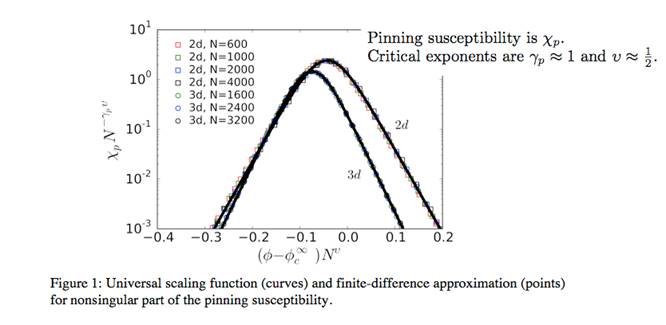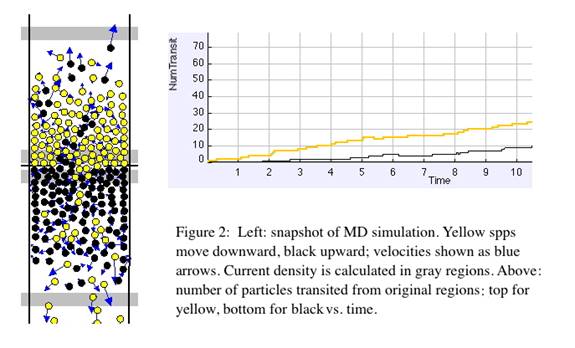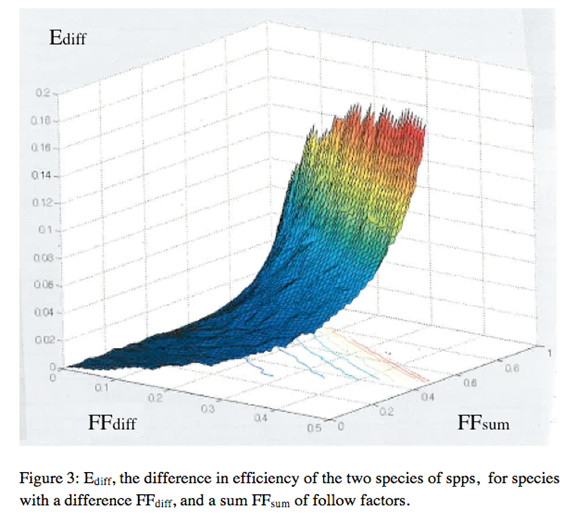Reports: UR551889-UR5: Fundamental Simulations of Jamming in Confining Geometries: Effects from Surfaces, Obstacles and Exits
Amy L. Graves, PhD, Swarthmore College
Future directions listed in our second year report were:
1) Which regular lattice geometries best support jamming in 2d and 3d, and why? …
2) (Issues) related to the flow of both physical and self-propelled particles through apertures were raised in our grant application but have not yet been tackled. It is hoped that we can create time to write codes to address important problems of this type.
In the third year, we tackled 2). Two undergraduates, Eduard Saakashvili ‘17 and Rachel Diamond ‘18, built on work begun by Travis Pollen ‘11 to write molecular dynamics (MD) simulations of self-propelled particles (spps). These traverse a region narrowed by an aperture ("doorway"). Figure 2 is a snapshot of simulated bidirectional flow: two oppositely directed species of of spps, with dynamics controlled by a social force model [1].
We find a novel emergent behavior based on the control parameter FF, a "follow factor". That is, particle ihas a velocity direction which attempts to relax to:
(In models of human transport, FF is associated with degree of "panic".) One may characterize transport via, for example, the efficiency, E. This is defined as the ratio of speed in the direction of the goal, to the spps desired speed (a parameter in the social force model). Figure 3 shows difference in efficiency between the two species, plotted versus the sum and difference of follow factors. Interestingly, particularly in comparison with results for mono-directional flow through a narrow aperture, more efficient transport occurs for the species with the lower FF.
Systems as diverse as colloidal particles and farm animals display similar statistical behaviors under circumstances of passage through narrow apertures; of interest is the likelihood of clogging, revealed in the distribution of sizes of "bursts" of particles, and the lag time between bursts [2]. Figure 4 shows a typical time series of bursts, and a complementary cumulative distribution function of lag times. The long-time behavior suggests a power law. A rigorous analysis of this distribution and its dependence on control parameters like aperture size remains to be done (in the extension year of the grant).
Finally, we have begun to characterize bidirectional flow in terms of the information entropy, S:
The less-efficient, more turbulent behavior that accompanies higher FF is reflected in higher S. Thus, entropy seems a promising, concise way to characterize the dynamical state of self-propelled particles.
Our research on jamming has had positive impacts on students in the classroom and the lab. Two classroom students had an "aha moment" when they were at home cooking rice which came vacuum sealed as a solid block. They emailed excitedly to tell me that they realized their rice came in the form of "jammed macrostates". One of the students who had his/her first research experience in my lab wrote this in a report to Swarthmore College:
"My research experience this summer was incredibly rewarding. It gave me insight into what working in a lab means on a daily basis and gave me confidence in my ability to think critically, ask questions, and then do whatever is required to find answers."
During the third year of our grant, Nashed ‘15 became the founding physics editor of the SJS, "Swarthmore Journal of Science", written by and for undergraduates. He also contributed an article (Figure 5) on our research.
Saakashvili ‘17 and Diamond ‘18 accompanied me on visits to the Univ. of Pennsylvania to meet with our collaborators in Prof. Liu's group and hear talks on materials science, including a graduate student thesis defense. At summer's end, each wrote a poster and presented it at the Swarthmore Sigma Xi poster session.
The ACS PRF grant has continued to further my research career. I will give a plenary talk on our research at a national conference for undergraduate women in the physical sciences in October, 2015. For the first time, I was asked to give an invited talk at the International Conference on Computational Physics, CCP2015. (Regrettably, I had to decline given the conference dates; and hope to be re-invited in a future year.) I will contribute a short talk on our research at the Rutgers University Statistical Mechanics meeting in December, 2015, and hope to do the same – with Swarthmore students accompanying - at the March meeting of the APS in 2016. I was invited to serve on the NSF Graduate Research Fellowship panel in December, 2014, and on the APS Apker Award panel in June-August, 2015. The Apker award honors the best undergraduate researcher in physics; the panel is a small number of senior faculty members with active research programs. Thanks to the ACS PRF, I indeed have an active research program. I am able to contribute as a peer in the greater scientific community, and to enthuse and educate students about cutting edge work in soft condensed matter and chemical physics.
References:
[1] "Simulating dynamical features of escape panic", D. Helbing, I. Farkas and T. Vicsek, Nature 407, 487-490 (2000).
[2] "Clogging transition of many-particle systems flowing through bottlenecks", I. Zuriguel et al. Sci. Rep. 4, 7324; DOI:10.1038/srep07324 (2014).


















